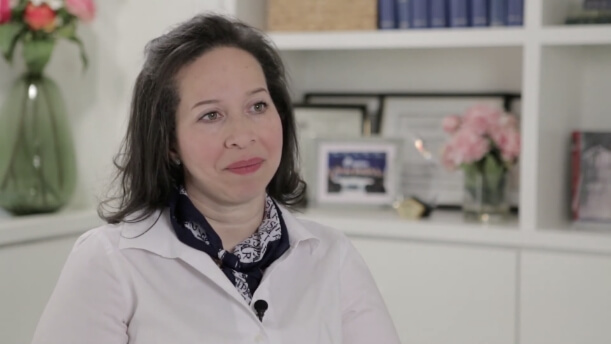
How to Give Yourself the Best Chance for a Normal Breast Shape After Mastectomy: Designing Your Surgical Incisions to Preserve the Skin Envelope of Your Breast
Many people who have seen a woman’s chest after mastectomy have been exposed to the bold horizontal line that marks the spot where the breast existed before it was amputated. The preoperative markings for a traditional mastectomy look like an eye drawn on the breast to indicate the area of skin that will be cut out with the nipple-areola complex in the middle where the iris of the eye would be. The breast tissue is removed through this large opening. Cutting out this football-shaped section of skin permanently flattens the three-dimensional shape of the breast – even after breast reconstruction, especially if the breast reconstruction is performed using breast implants. Although this is the design of a traditional mastectomy, it is possible to preserve the shape of a normal breast with a little bit of foresight. By using plastic surgery techniques, the breast surgeon can do her mastectomy through a different incision that preserves the skin envelope of the breast so that a natural breast shape with projection is maintained after breast reconstruction.
The most obvious way to preserve the skin envelope is to preserve the nipple-areola complex. If the patient’s tumor is not involved with the nipple, then she may be a candidate for a nipple-sparing mastectomy. In breast surgery that spares the nipple, an incision is made on the breast, but none of the breast skin is actually removed. If a woman does not have breast cancer, and she is undergoing mastectomy for prophylaxis (eg., genetic mutations such as BRCA, CHEK2, p53, etc), then there is no oncological advantage for her to remove her nipple. Likewise, if the woman’s tumor is located far from the nipple-areola complex, then multiple studies have demonstrated that saving the nipple is safe. That said, not all breast surgeons have been trained to perform nipple-sparing mastectomies, and sometimes a nipple-sparing mastectomy can be technically more difficult to perform than a traditional mastectomy that removes a large section of breast skin. A patient needs to make sure that a breast surgeon who tells her that she is “not a candidate” for a nipple-sparing mastectomy is actually experienced performing nipple-sparing mastectomies in her practice, and is not telling the patient that she is “not a candidate” because the breast surgeon does not feel comfortable performing nipple-sparing mastectomies herself. For the patient, it is worth the effort to find a breast surgeon who is skilled in performing nipple-sparing mastectomy because the reward is a normal-looking breast for the rest of her life.
In a nipple-sparing mastectomy, incisions can be placed in different areas of the breast depending on the woman’s original breast shape. For women with perky breasts, the incision can be placed in the inframammary fold, which is located along the lower edge of the breast. When a woman undergoes mastectomy via an inframammary fold incision, it can be very difficult to see the scar after breast reconstruction – especially when the lower part of her breasts cover the inframammary fold. When a woman undergoes implant-based breast reconstruction, the breast takes on the shape of the breast implant, which may also contract and shrink over time. Sometimes, the inframammary fold of an implant-based breast reconstruction may be blunted so that there is not a clear distinction between bottom of the breast and the upper abdomen. The most natural shape in a reconstructed breast comes from a natural tissue breast reconstruction because the breast will have the weight and softness of a regular breast.
In a woman with droopy breasts, the best incision for a nipple-sparing mastectomy is usually a vertical incision from the lower edge of the areola to the inframammary fold. If she is having an implant-based breast reconstruction, then she may need a breast lift before mastectomy so that the nipple is not in the wrong place after the breast reconstruction. Once she has healed from the breast lift, then the breast surgeon can use the scars from the breast lift to remove the breast tissue and then the plastic surgeon can replace the breast tissue with a tissue expander and/or implant. Since the implant is artificial with no blood supply, the nipple cannot be moved over an implant without risking complete nipple loss. If a woman with droopy breasts is having natural tissue breast reconstruction, then the mastectomy and breast reconstruction can be performed immediately via the vertical incision. Often, after natural tissue breast reconstruction, even women with droopy breasts will have breasts that appear at least slightly lifted. If the breasts are not lifted enough, then the plastic surgeon can lift the breasts using the same vertical incision in a later surgery. Since natural tissue has a normal blood supply like any other part of the body, the nipple can be moved after natural tissue breast reconstruction as if it were the patient’s original breasts. Either way, the skin envelope is preserved along with the breast shape, and the scarring is similar to or less than than the scarring from a standard cosmetic breast lift or breast reduction.
If a woman has had other breast surgeries – such as breast biopsies or lumpectomies – then it may also be possible to incorporate the previous scars into the mastectomy. For example, if she has a scar on the side of her breast, it may be possible to incorporate this scar to perform the mastectomy. The plastic surgeon can then figure out how to obtain the best breast shape using the scars that already exist. Many of the challenges in obtaining the best breast shape with the least amount of scarring depend on finding a plastic surgeon who is smart, creative, and cares enough to think outside the box to obtain the best possible result.
If a woman is not a candidate for a nipple-sparing mastectomy, then it is still possible to preserve the skin envelope and ultimate breast shape by carefully designing the incision prior to performing the mastectomy. Importantly, a traditional mastectomy that removes an eye-shaped area of skin will flatten and distort the breast shape, even if it only leaves a small short horizontal line. The horizontal scar across the dome of the breast always distorts the shape and flattens the breast. In order to preserve the breast shape, the breast surgeon and the plastic surgeon must work together to maintain the original contours of the breast.
When a nipple-sparing mastectomy is not possible for oncological reasons (eg, bloody nipple discharge, tumor too close to the nipple-areola complex, etc.), the easiest way to preserve the skin envelope is to use a periareolar incision with a vertical extension. The periareolar incision cuts out the nipple-areola complex as a circle, and then a vertical line is made from the bottom of the areola extended to the inframammary fold. This incision should give the breast surgeon plenty of access to remove the entire breast. If the breast is very large and she needs a bigger incision, then a horizontal extension hugging the bottom border of the breast can be made that curves along the inframammary fold in an anchor-like design. The only skin that is actually removed is the circle of the nipple-areola complex. The vertical and, if necessary, horizontal lines are incisions only without skin resection. If the patient is undergoing implant-based breast reconstruction, then the circular space that is left where the nipple-areola complex used to be can be closed in a pursestring fashion by the plastic surgeon. If the patient is undergoing natural tissue breast reconstruction, then the skin island from the patient’s tissue replaces the circular areola immediately. Either way, the skin envelope is preserved along with the breast shape, and then final scars are essentially identical to a standard cosmetic breast lift or breast reduction.
If a woman is lucky enough to find a very talented breast surgeon and plastic surgeon team, and she is not a candidate for a nipple-sparing mastectomy, then she may also be able to undergo a skin-sparing mastectomy via a periareolar incision only. In this operation, the entire mastectomy is performed through a periareolar incision without a vertical or horizontal incision. Since a complete mastectomy must be performed through the circular cutout that is left where the nipple-areola complex used to be, the areola must be large enough for the breast surgeon to be able to gain access to the entire breast. If the patient is undergoing implant-based breast reconstruction, it is usually not going to be a problem to perform the breast reconstruction through the circular cutout because it is a larger access incision than many cosmetic breast augmentations. The skin is closed in a pursestring fashion without additional scars, thus preserving the entire breast envelope. If the patient is undergoing natural tissue breast reconstruction with microsurgery, then the patient needs to have a large areola that leaves enough room for the plastic surgeon to reach the blood vessels of her chest wall so that she can safely reconnect the patient’s blood vessels under an operating microscope. The skin island from the natural tissue then replaces the patient’s areolar circle immediately without any additional scars. With a skin-sparing mastectomy that removes the nipple-areola complex and is performed through a periareolar incision only, the only scars will be from the removal of the nipple-areolar complex, and the skin envelope of the breast will be completely preserved.
The key is to find a breast surgeon and a plastic surgeon who care enough about the final result to preserve the original shape of the breast. A traditional mastectomy that removes an almond-shaped area of skin is the fallback of most breast surgeons, and the overwhelming majority of breast surgeons have only been trained in traditional mastectomy techniques that lop off the dome of the breast and leave a horizontal scar permanently deforming and flattening the breast. Most have not been trained to think about how to preserve the contours of the breast resulting in a more natural shape. Sometimes a breast surgeon will call their mastectomy “skin-sparing” because the horizontal line is short, but if the mastectomy leaves the telltale horizontal scar where the breast used to be, then it is basically a traditional non-skin-sparing mastectomy. Women who want to optimize the ultimate appearance and shape of their breast(s) after mastectomy and breast reconstruction must take control of their bodies and do their homework in advance. The simple decision of what incision is used to perform a mastectomy can affect the final outcome of a woman’s post-mastectomy breast reconstruction forever.


